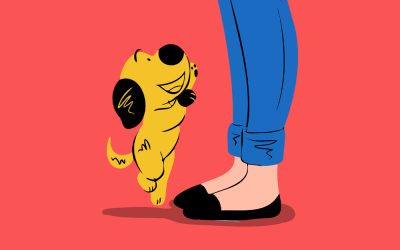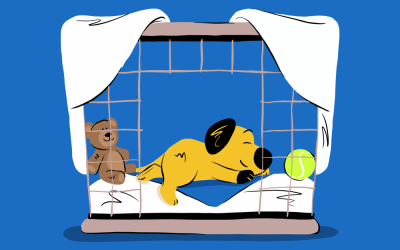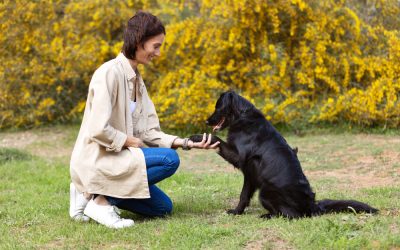Identifying Your Puppy’s Body Language

Updated November 14, 2025
Bringing a puppy into your home is an exciting experience, but it also comes with a learning curve. Puppies are bundles of energy, curiosity, and emotion, and they rely heavily on body language to convey their emotions. Learning to recognize what your puppy is trying to tell you helps reduce confusion, prevent stress, and strengthen the bond between you and your furry friend.
Just like humans use words and tone, puppies use posture, movement, and expression to share their feelings. Paying attention to these cues allows you to respond appropriately, whether they’re asking for playtime, comfort, or a moment of rest.
Why Understanding Puppy Body Language Matters
Recognizing your puppy’s signals goes beyond knowing when they’re happy or tired. It’s also about recognizing early signs of stress, discomfort, or fear before they escalate into larger issues.
For example, a puppy that frequently licks their lips or yawns when not tired may be feeling anxious. By noticing and responding to these subtle cues, you can help your puppy feel more secure and confident in their environment.
Understanding these signals doesn’t just prevent behavioral problems; it builds trust. When your puppy feels understood, they’re more likely to relax, learn quickly, and form a lasting bond with you.

Common Puppy Body Language Cues
Puppies express their emotions through a combination of signals, such as tail position, ears, facial expressions, and overall posture. Here are some of the most common cues to look for:
Tail Language
- High and Wagging: Usually a sign of happiness or confidence.
- Low or Tucked: Indicates fear or uncertainty.
- Stiff and Upright: Can mean alertness or even aggression.
The key is context. A fast, loose wag typically means excitement, while a slow, stiff wag can indicate tension.
Ear Positions
- Perked Up: Shows
- Flattened Back: Often signals fear or submission.
- Relaxed: Suggests calmness and comfort.
If your puppy’s ears go flat in a new environment, it might mean they need reassurance.
Facial Expressions
- Soft Eyes and Relaxed Mouth: Indicate contentment and ease.
- Wide Eyes: Suggest surprise or anxiety.
- Tense Mouth or Furrowed Brow: Can be signs of stress.
A puppy’s eyes and mouth often reflect their emotional state; keep an eye on both for subtle clues.
Reading Posture and Movement
A puppy’s body posture provides one of the clearest indicators of how they’re feeling.
- Loose, Wiggly Movements: Show happiness and confidence.
- Crouched or Low Posture: Indicates fear or submission.
- Stiff or Rigid Stance: Suggests alertness or unease

Understanding Playtime Signals
Play is an essential part of your puppy’s development. It helps them learn boundaries and build trust with both humans and other dogs. Recognizing play cues helps keep interactions safe and fun.
- Play Bow: Front legs stretched forward, rear end up—an open invitation to play.
- Bouncy Movements: Indicate excitement and joy.
- Gentle Mouthing: A normal way for puppies to interact socially.
Recognizing Signs of Stress or Discomfort
Even playful puppies experience stress. Recognizing these signals helps you support them before anxiety builds up.
- Pacing or Restlessness: Signs of unease or overstimulation.
- Excessive Licking or Chewing: Possible self-soothing behaviors linked to stress.
- Avoidance or Hiding: Indicates fear or discomfort.
Creating a Safe and Supportive Environment
Your puppy looks to you for guidance and reassurance. Here are a few ways to create an environment that encourages trust:
- Observe Regularly: The more time you spend watching your puppy, the better you’ll understand their signals.
- Respond Calmly: Your tone and body language affect how your puppy feels.
- Use Positive Reinforcement: Reward calm or confident behavior with treats and praise.
- Provide Comfort: Offer affection or quiet time when your puppy feels anxious.
Strengthening the Bond with Your Puppy
Understanding your puppy’s body language is one of the most rewarding parts of pet ownership. It turns training into communication and deepens your emotional connection.
By observing, responding with patience, and providing consistent reassurance, you’ll build a strong foundation of trust. A puppy who feels understood grows into a confident, well-adjusted dog, and that’s the ultimate reward for any pet parent.
FAQs
Why is understanding puppy body language important?
Puppies primarily communicate their wants, needs, happiness, and fear through body language. Understanding signals helps you build trust, strengthen relationships, help puppies adjust to situations, prevent problems, provide proper training/socialization, and recognize stress/anxiety/discomfort. Look at the WHOLE picture—all body parts together plus context—not just one signal. Each cue could mean various things alone.
What do tail positions and wags mean?
- Happy/excited: Fast wags with hind-end wiggles, vigorous mid-level wagging.
- Uncertain/cautious: Slow wags, slow low-level wags.
- Confident: Perky tail pointed toward the ceiling.
- Fearful: Tail clamped over rear/pointed down, tucked between legs.
- Alert/aggressive: Tail high and stiff, slow wag with high tail (dominance/threat response). Wagging doesn’t always mean happy. Speed, direction, and position matter!
What do eyes, ears, and mouth reveal?
- Eyes: Squinty (happy/pleased), wide-open/dilated pupils (alert/aggressive), whale eyes/showing whites (distress/fear/anxiety), averted gaze (submission/stress), staring (challenge/dominance).
- Ears: Forward/erect (alert/interested), pulled back/flat (fear/anxiety/submission), natural relaxed position (calm/comfortable).
- Mouth: Teeth bared menacingly (threatened/aggressive), full teeth showing relaxed (happy/”smile”), open/relaxed (comfortable), tightly closed/corners back (fearful), panting/lip-licking without cause (stress/anxiety).
What does raised fur (hackles) mean?
A strip of hair standing up along the back may indicate intense aggression or fear, but also excitement, over-arousal, or feeling overwhelmed. Not always clear and sometimes involuntary. Read the rest of the body language, combined with hackles, to gauge genuine emotions.
What do different body postures mean?
- Relaxed/happy: Loose wiggly body, weight evenly distributed, soft movements, may expose belly.
- Confident/alert: Upright stance, weight forward, trying to appear larger, approaching something of interest.
- Fearful/submissive: Stiff low body, weight shifted back, trying to appear smaller, lowered head, cowering, flattened ears, tucked tail.
- Aggressive/defensive: Rigid tense body, minimal movement, weight forward in “ready” stance, stiff-legged, raised fur.
- Play bow: Chest on ground, rump in air—invitation to play!
How can I use this knowledge to help my puppy?
Start learning from day one! Understanding body language helps build trust, facilitate training, recognize when a puppy is ready to learn vs. overwhelmed/stressed, gauge confidence during new experiences, and help them become well-adjusted.
Stress signals: Yawning, lip-licking, whale eyes, ears back, tucked tail, panting, trembling. If the puppy shows fear/aggression, don’t punish—remove them from the stressful situation, give space, gradually desensitize, and consult a professional trainer. Practice observing in different situations and trust your instincts as you learn your puppy’s unique communication style!



